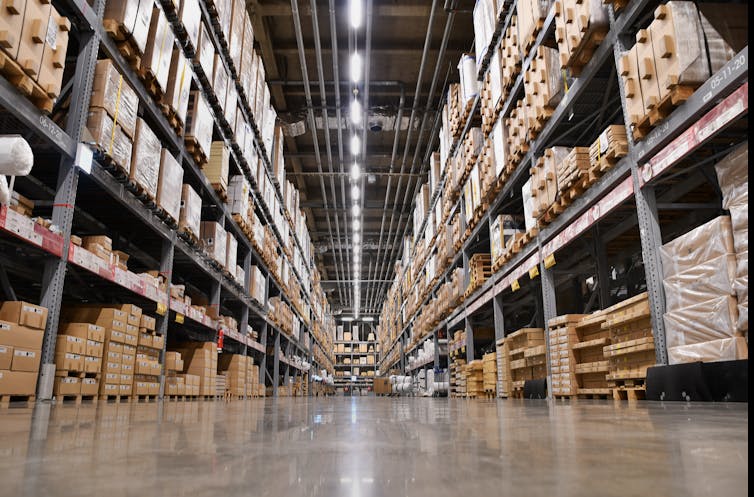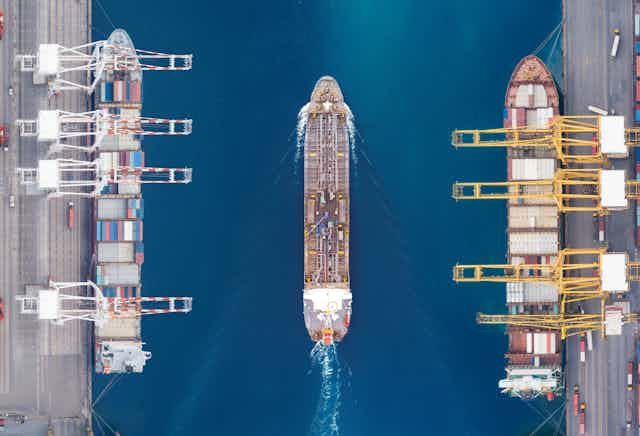When the coronavirus crisis erupted in 2020, it became apparent that the medical emergency was accompanied by severe shortages, especially in some medical devices.
The pattern was first observed for ventilators: demand spiked everywhere and the supply chain was disrupted. This was because production of the devices spanned multiple countries, with each part dependent on other parts manufactured in different locations. The longer the chain and the more complex the dependence, the greater the exposure of any point to the disruption of another one, and to mandated shutdowns.
Now, two years since Covid first hit, this pattern has affected almost every sector of the global economy. “Supply chain issues” have become so widespread that they are now a running joke, affecting everything from furniture to groceries. But why has Covid had such a severe effect on how we receive products and goods?
In recent decades, supply chains became lean, and they lengthened as they became more cost-efficient: more and more steps were added in the manufacture and transportation of any given product in the name of speed and cost. This means there are more and more places where something can go wrong between you ordering something online and it arriving to your door.

Today, downstream suppliers – such as those who provide vehicle control systems to your car manufacturer – depend on upstream suppliers – such as chip manufacturers – to deliver on time so they can in turn deliver on time to you.
With long chains, risks are now shared between multiple entities all around the world.
Using AI and blockchain to protect trade
Supply chain problems have a knock-on financial effect known as trade credit contagion. This is where firms delay payments to suppliers because their customers delay payments to them. The pay-on-delivery model can lead to cancelled or delayed shipments which can in turn lead to bankruptcies.
While a high proportion of trade credit risk remains uninsured today, a post-pandemic world may see insurance and reinsurance firms fill in this protection gap.
Researchers are currently working to develop methodologies to identify vulnerabilities in global supply chains and to understand their trade credit contagion risks. The goal is to make these systems more robust overall.
How can we design ways to design insurance and reinsurance contracts in order to effectively share the risk and mitigate vulnerabilities? How can reliable trade credit lead to fewer delays in supply chains and replace the familiar predicament we face now, of paying for something in advance with an unknown delivery date?
Artificial intelligence and complex network theory are helpful in identifying the structures that could pose systemic risk. They help us ask: which patterns of connections are likely to lead to delay and trade credit contagion and which are more robust?
Using these tools, we can create large-scale simulators of global supply chains responding to a wide variety of shocks and then use machine learning techniques to detect the problematic parts of the chain. This knowledge can then be used in market designs that strengthen the system before another pandemic or disaster occurs.
Other novel technologies such as blockchain bring the promise of using high quality data to analyse supply chain dependencies. blockchain technology uses real-time data and transparent verification carried out by multiple parties. In combination with other features, such as smart contracts, this could lead to timely resolution in cases of disputes along the supply chain.

My research involves
using blockchain to streamline record-keeping and payments. This problem is challenging because the adoption of blockchain depends both on the specifics of the technology and the cost.
The problem of adopting technology in the presence of positive externalities (whereby firms adopting the technology in turn improve the operations of external parties) is an old one in economics, but now these externalities are systemic in nature: the effects propagate along the chains. The cost of the technology depends on how many firms adopt it, and each one faces business specific costs based on its position in the supply chain, its risk tolerance and its costs to insure these risks.
Real-time recording keeping, the traceability of transactions, and the immutability of blockchain can all help supply chains become more efficient. This is all the more true if we consider the full length of the chain, where transactions need to be verified by several parties: participants in the supply chain, insurance and reinsurance firms.
The future of supply chains
Trade credit insurance is likely to grow after the pandemic. It may rely on private-public partnerships – the pandemic has shown that governments become important players when they impose shutdowns in certain areas.
These funds can be used to make up for payment delays, reduce losses and jump-start critical production where necessary. But not all links in a chain can be insured, and an important challenge is to identify the most important stages under different shock scenarios.
Supply chains can also be rewired – large-scale algorithms can identify which suppliers need to be replaced and which new ones need to emerge.
In a few years, supply chains may look different, as the overall goal shifts from minimising costs, as was the case before the pandemic, to minimising delays and trade credit risks. The end consumer will drive the need to rewire the network, as demand shifts. Ultimately, the flexibility of the customer determines the resilience of the supply chain.

Created in 2007 to help accelerate and share scientific knowledge on key societal issues, the AXA Research Fund has been supporting nearly 650 projects around the world conducted by researchers from 55 countries. To learn more, visit the site of the Axa Research Fund or follow on Twitter @AXAResearchFund.


